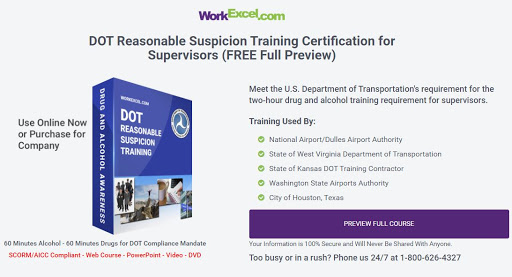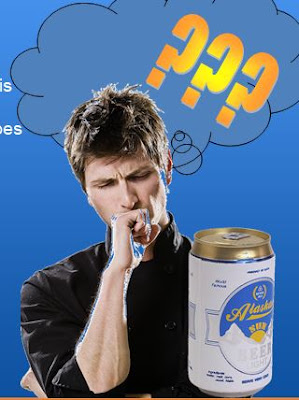What is the Supervisor’s Role?
As a supervisor, you have an
important role in dealing with alcohol problems in the workplace. These problems appear as a host of behavior, conduct, attitude, quality of work, and attendance or availability issues that wreak havoc on productivity. Training in substance abuse (whether DOT or Non-DOT in scope, can help you act sooner when you witness these sorts of problems.)
In your daily responsibilities monitoring your employees’ work and on-the-job behaviors and their conduct, your
basic supervisory responsibilities may include and are not limited to:
- assigning, monitoring, reviewing, and appraising work
and performance
- setting work schedules, approving or disapproving
leave requests
- taking necessary corrective and disciplinary actions
when performance or conduct problems arise
- referring employees to your agency’s Employee
Assistance Program (EAP)and other resources
- hiring, promoting and terminating employees
As a DOT supervisor concerned with reasonable suspicion of substance abuse, you will likely have to deal with employees with problems related to substance abuse which may impact safety, performance, conduct, and sickness/leave
problems.
In some cases, you may not know for sure, but do suspect that there is
an alcohol problem, but haven’t yet seen a direct impact of the alcohol use on job performance.
As a DOT supervisor, all of these roles you play create can be challenging, especially when it involves having an employee
who is “functional” in their work performance, but has unpredictable alcohol related problems. This employee is particularly difficult to confront because their
work performance is often not detectably impacted.
Eventually however, the employee
may be intoxicated while at work or come to work still a bit “buzzed’ and participate
in risky decision making or dangerous behaviors. They could be in an accident
or be arrested for drunk driving. Your role is not to diagnose the alcohol
problem but to engage in a proactive role in dealing with the performance or behavior
problem, hold the employee accountable, document and refer the employee to the
EAP, and take any appropriate disciplinary action.
Your proactive role in dealing
with alcoholism in the workplace is crucial. The most effective way to get an alcoholic
to deal with the problem is to make the alcoholic aware that his or her job is
on the line. You send a message that they have to face their substance abuse,
access EAP programs and supports, and improve performance, or they will face the
serious the possibility of losing his or her job.
As a DOT supervisor it isn’t your role to diagnose but it is
your responsibility to safeguard the health and safety of your employee and the
organization.
Reasonable Suspicion Training, required under federal law, trains
DOT supervisors to identify the signs and symptoms of drug and alcohol use and
abuse. The Reasonable Suspicion training highlights the need to take action as
an integral part of the process for change
The
terms “problem drinker” and “functional alcoholic” are labels that support
denial. Unfortunately, they help the alcoholic continue drinking unaffected by
the anxiety of self-awareness. These two labels although commonly used even by
health care workers, are not medical terms.
The term “functional” and “problem
drinker” only negatively help the alcoholic, their family, and/or friends and
co-workers/supervisors to make sense of or compare the person, in the context
of familiar ideas or terms, to an idea of an illness that feels less threatening
or dangerous.
For
many, the role of enabling an employee with alcohol abusive behaviors typically
feels like the "right" thing to do in response to the problem
behavior. Actually, unfortunately, it helps the alcoholic or addict escape
responsibility for their actions.
The ability of the addict to deny, rationalize,
externalize, and minimize problems while having others accept their excuses and
explanations, ends up helping the addict get sicker and exposes the company
to a myriad of risks and expenses in monetary and human cost.
Even though you must not try to
diagnose the problem, you should be aware of both the obvious and sometimes
more subtle signs that may indicate a problem with alcohol or drug abuse which should
trigger a referral to the EAP. Recognizing, documenting and identifying these
are a strong first step in the process.
Employees will show irregularities or
instances in these areas:
Changes in Leave, Tardiness and Attendance, or general behavioral
changes
·
Increased
or new unexplained/unauthorized absences from work
·
Frequent
tardiness, increased use of sick leave
·
Patterns
of absence, like the day after payday or frequent Monday or Friday absences
·
Frequent
unplanned absences due to "emergencies" (e.g., household repairs, car
trouble, family emergencies, legal problems)
·
The
employee may also leave their duty station without explanation or permission
for significant periods of time, frequent bathroom breaks, odd changes in
eating habits, glassy eyes, smells of alcohol or drugs
Performance
Problems:
- Careless, sloppy work or
incomplete assignments or reports
- Production quotas not met,
late with delivery of shipments, late arrival of shipments or truckloads
- Many or repetitive excuses that
may seem plausible
- Poor decision making, risky behaviors,
blaming others
Often in jobs requiring long-term projects
or detailed reports that take time, an employee may be able to hide a
performance problem for quite some time. In positions where driving or use of
machinery is involved, the immediate exposure to risk and injury is increased
and enormous.
Relationships
at Work with coworkers and management:
- Relationships with coworkers
will likely become strained and involve conflict or volatility
- Often the employee may be
belligerent, argumentative, or short-tempered, especially in the mornings
or after weekends or holidays. Often, they may be in a mood, or
unpredictable and then feel guilty later
- The employee may become a
"loner", or avoid people and work events
Behavior and Appearance
at Work:
The general appearance
of being inebriated or under the influence of alcohol may include but not
be limited to:
- The smell
of alcohol or any drug substance on the breath, clothing or even in a vehicle
- An unsteady
gait, or frequent injuries attributed to a fall or just being “clumsy”
- Bloodshot
eyes
- Moodiness,
increased behavior changes or volatility
- Excessive
use of mouthwash, breath mints, gum
- May avoid supervisory
contact, especially after lunch or first thing in the morning
- Changes in
appetite or eating habits- not eating, binge eating, throwing up, excessive
thirst
- Tremors or
sudden seizures, frequent headaches
- Napping or
sleeping while at work
Not any single one of these signs
means that an employee is an alcoholic. However, when these warning signs are
coupled with performance, behavior or decision-making problems, it’s important
to carefully document and make a referral to the EAP for an assessment so that
the employee can get appropriate access to help.
Signs of a Functional Alcoholic
Since
there is no such thing as a ‘functional alcoholic”, the signs and symptoms of alcoholism
and substance abuse are the same as for a functional alcoholic. Many people hold
the misconception of the classic picture of an alcoholic as someone who always
drinks too much and whose life is falling apart because of it, but that's not
always the reality. In reality, often times an employee may not drink for periods
of time and/or then binge drink, then the next day they may still be under the
influence when they arrive to work. They may drink every day consuming alcohol
at varying times or repetitive times i.e. “another nightcap” or an “eye opener”.
The misconceptions of what an
alcoholic is, is often tied to the idea of what people call “functional” or
“high-functioning" alcoholics. After all, they are getting their job done…but
they are actually flying under the radar. You can still be an alcoholic, even
though you have a great “outside life,” with a job that pays, a home, a family,
friendships, and social bonds.
It’s all still problem drinking,
even if you think it's “mild” or “functional”. Remember that the pattern
of behaviors you observe will vary dependent on whether they are using alcohol
or illegal drugs.
What Are the Signs?
For women having more than three
drinks a day or seven drinks a week, is considered heavy drinking and for men,
it's four or more per day or 14 drinks in a week. If you drink more than the
daily or weekly limit, you’re at risk for a range of problems and alcoholism.
There are some other red flags you
should watch for:
- They aren’t keeping up with major responsibilities at work
- They are losing friendships or having relationship problems
- They have legal problems related to drinking, such as a DUI arrest
- They seem to need alcohol to relax or feel confident
- They will drink in the morning or alone or on the job
- Get drunk when you don’t intend to
- Forget what you did while drinking
- They will lie about drinking, hide alcohol, or get angry or
defensive when confronted about drinking
Confronting an
employee suspected of substance abuse
There are 5 basic skills that you
should be familiar and comfortable with to become a proactive participant in a DOT
substance awareness and abuse policy intervention.
Skill
1...Sharpen your observational powers so you can intervene earlier
Skill
2...Take a proactive role- don’t wait
Skill
3...Document your suspicion
Skill
4...Act on the Drug Testing Policy in place with your workplace
And
skill 5...Communicate your suspicion to the employee and referring to testing
Facing the Challenge
Fighting
substance abuse in your workplace is one of the hardest and most complex
challenges you’ll face as a manager. Expect the following to occur:
- It may likely be difficult to
initiate a discussion of this delicate and personal topic to begin intervention
- Employee confrontations rarely
proceed smoothly and happily- make sure you have another manger or EAP
person present when you confront. Do not diagnosis
- Employees may be resistant at
first. You’ll need to stay calm and consistent. Consider the use of a script
to guide and focus you and your team when you meet
- Never perform an assessment
yourself, always refer
Why You Should Get Involved
Remember,
employees and your organization will benefit from professional counseling and
treatment. It may feel awkward, uncomfortable or even intense but by initiating
a proactive role, but everyone will benefit in the long run.
By stopping an impaired employee from driving a vehicle or operating machinery,
you may prevent accidents that cause permanent harm to the worker and others,
damage business image, impact insurance and increase exposure to future risk.
If you know what to look for - and what to do, you can proceed with confidence
and provide potentially life-saving support, a win-win for everyone.









